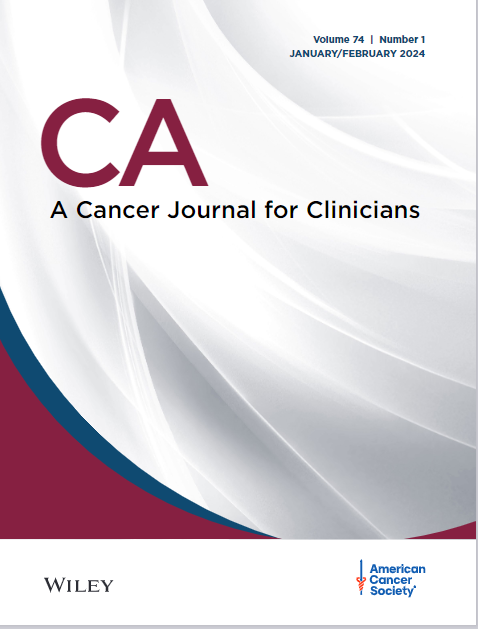Advances in pancreatic cancer early diagnosis, prevention, and treatment: The past, the present, and the future
IF 232.4
1区 医学
Q1 ONCOLOGY
引用次数: 0
Abstract
Pancreatic ductal adenocarcinoma (PDAC) is an aggressive malignancy with a dismal prognosis, largely because of late-stage diagnosis and therapeutic resistance. PDAC incidence has been rising, with modifiable and non-modifiable risk factors contributing to disease development. Chronic pancreatitis, diabetes mellitus, smoking, obesity, and familial predisposition have been implicated in PDAC pathogenesis. Early clinical manifestations are vague and insidious; therefore, PDAC is often diagnosed at an advanced stage, limiting curative treatment options. Efforts to improve early detection have focused on serum biomarkers (e.g., carbohydrate antigen 19-9), imaging modalities, and liquid biopsies. Endoscopic ultrasound and magnetic resonance imaging have demonstrated potential in identifying early-stage disease in certain high-risk populations. Surgical resection remains the only potentially curative option, but only 15%–20% of patients have resectable disease at diagnosis. Neoadjuvant chemotherapy has emerged as a promising strategy to improve resectability and survival outcomes. For patients with locally advanced or metastatic PDAC, combination chemotherapy regimens such as FOLFIRINOX (folinic acid, 5-fluorouracil, irinotecan, and oxaliplatin), NALIRIFOX (5-fluorouracil, oxaliplatin, liposomal irinotecan, and leucovorin), and combined gemcitabine/nanoparticle albumen-bound paclitaxel offer survival benefits, although toxicity remains a concern, especially for platinum-based therapies. Several breakthroughs in molecular profiling have led to the development of targeted therapies, including sotorasib and olaparib. Immunotherapy has shown limited success in PDAC due to its immunosuppressive tumor microenvironment. However, novel combination approaches are under investigation, including quadruplet therapy, immune checkpoint inhibitors with oncolytic viruses, stromal-targeting agents, and personalized neoantigen vaccines. Key priorities for future research include identifying reliable biomarkers for early detection, refining patient selection for targeted therapies, and developing innovative strategies to overcome treatment resistance.胰腺癌早期诊断、预防和治疗的进展:过去、现在和未来
胰腺导管腺癌(Pancreatic ductal adencarcinoma, PDAC)是一种预后不佳的侵袭性恶性肿瘤,主要是因为其诊断较晚且治疗有耐药性。PDAC发病率一直在上升,可改变和不可改变的风险因素有助于疾病的发展。慢性胰腺炎、糖尿病、吸烟、肥胖和家族易感性都与PDAC的发病机制有关。早期临床表现模糊、隐匿;因此,PDAC通常在晚期才被诊断出来,限制了治疗选择。改善早期检测的努力主要集中在血清生物标志物(如碳水化合物抗原19-9)、成像方式和液体活检上。内窥镜超声和磁共振成像已经证明了在某些高危人群中识别早期疾病的潜力。手术切除仍然是唯一可能治愈的选择,但只有15%-20%的患者在诊断时可切除。新辅助化疗已成为一种有希望改善可切除性和生存结果的策略。对于局部晚期或转移性PDAC患者,联合化疗方案如FOLFIRINOX(亚叶酸、5-氟尿嘧啶、伊立替康和奥沙利铂)、NALIRIFOX(5-氟尿嘧啶、奥沙利铂、伊立替康脂体和亚叶酸钙)和吉西他滨/纳米颗粒蛋白结合紫杉醇联合化疗方案提供了生存益处,尽管毒性仍然是一个问题,特别是铂基治疗。在分子分析方面的一些突破导致了靶向治疗的发展,包括sotorasib和olaparib。由于其免疫抑制肿瘤微环境,免疫治疗在PDAC中显示出有限的成功。然而,新的联合治疗方法正在研究中,包括四联体治疗、溶瘤病毒免疫检查点抑制剂、基质靶向药物和个体化新抗原疫苗。未来研究的重点包括确定早期检测的可靠生物标志物,改进靶向治疗的患者选择,以及开发克服治疗耐药性的创新策略。
本文章由计算机程序翻译,如有差异,请以英文原文为准。
求助全文
约1分钟内获得全文
求助全文
来源期刊
CiteScore
873.20
自引率
0.10%
发文量
51
审稿时长
1 months
期刊介绍:
CA: A Cancer Journal for Clinicians" has been published by the American Cancer Society since 1950, making it one of the oldest peer-reviewed journals in oncology. It maintains the highest impact factor among all ISI-ranked journals. The journal effectively reaches a broad and diverse audience of health professionals, offering a unique platform to disseminate information on cancer prevention, early detection, various treatment modalities, palliative care, advocacy matters, quality-of-life topics, and more. As the premier journal of the American Cancer Society, it publishes mission-driven content that significantly influences patient care.

 求助内容:
求助内容: 应助结果提醒方式:
应助结果提醒方式:


